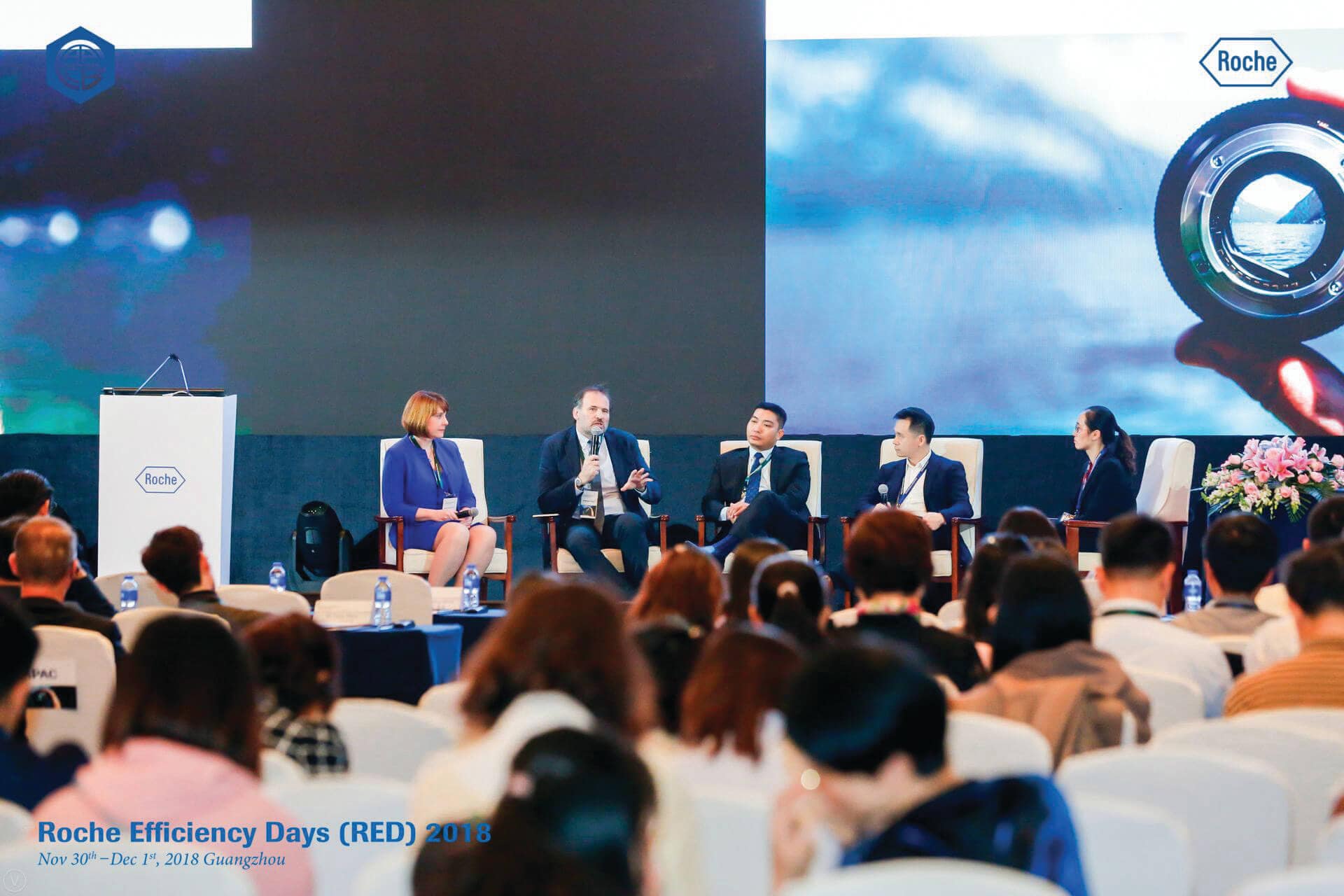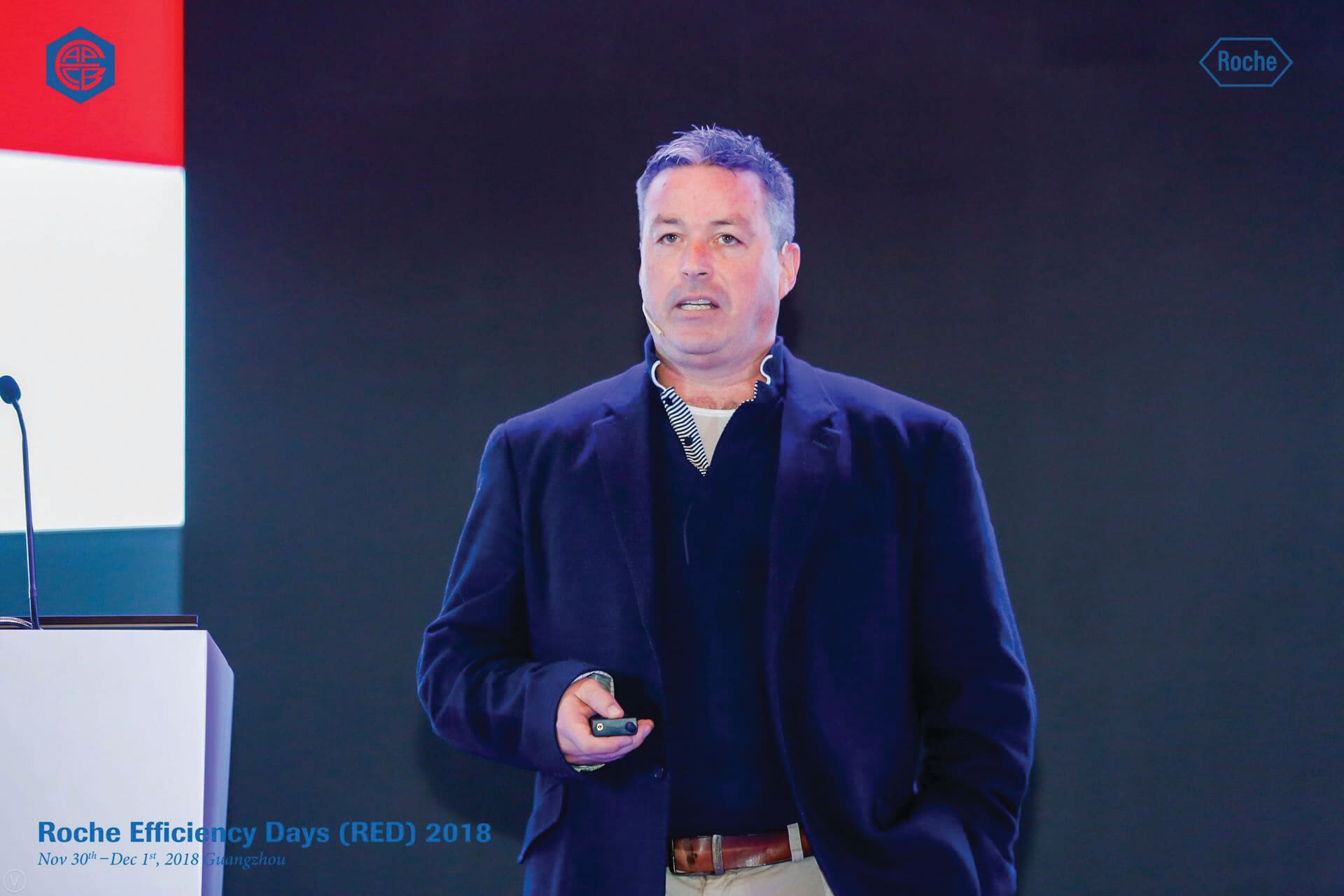In the last quarter of 2018, laboratory industry leaders from across the world converged in Guangzhou, China, for the Roche Efficiency Day (RED). While exploring the theme ‘REDefine perspectives’, many presenters and many presenters and panelists reflected on how artificial intelligence (AI), big data, automation, and other digital technologies in healthcare continue to re-shape the future of the healthcare industry. But amid those discussions, another theme emerged – the enduring value of human intelligence and interpersonal relationships. While acknowledging the transformative power of digital technology and automation, several laboratory leaders emphasised the vital role that smart, passionate people will play in the future of the laboratory industry. Roche Diagram magazine spoke to a handful of those leaders to find out why they believe the laboratory of the future will be more – not less – human.

Since 2016, Roche Efficiency Days (known to attendees simply as RED) have provided a forum for bold discussions around emerging trends in the Asia Pacific laboratory industry. Featuring industry thought leaders from around the world, RED sparks lively conversations while providing everyone in attendance a rare glimpse into the future of their field.
Unsurprisingly, automation, AI and big data have been hot conversation topics at every RED to date. In past years, these discussions have been accompanied by a concern that advancing technology may diminish the role of the laboratory technician. But at RED 2018, several leaders made it clear that tomorrow’s most successful laboratories will be those which emphasise, and even amplify, the role of humans.
Automation as human empowerment
‘Automation’ can be a scary word, conjuring images of hyper-efficient robots that work faster – and cheaper – than people. Certainly, automation is not always good news for workers. In the last century, automated processes vastly improved productivity and efficiency in the manufacturing and agricultural industries, while reducing the need for human workers on farms and in factories. So it seems fair to ask: could the same thing happen to the in-vitro diagnostics (IVD) industry?
To a significant degree, automation has already transformed how clinical laboratories operate. The advent of digital technology in healthcare has relegated handwritten results to being thing of the past. Test ordering is fully automated. Routing is often handled by pneumatic tubes.
These changes have reduced manual labour while improving efficiency throughout the testing process. According to Dr Andri Hidayat, more advances are coming. But he says they will not replace laboratory technicians. On the contrary, they will free technicians up to do more meaningful, satisfying work.
As the Operations & Information Technology Director at Prodia Laboratory – the biggest commercial laboratory in Indonesia – Dr Hidayat spends his days implementing information technology (IT) solutions to improve laboratory efficiency. At Prodia, he recently oversaw the launch of a chatbot named ‘Tania Prodia’, which interacts with customers via social media, creating a more personal healthcare experience.
While the chatbot may have a human name, its purpose is not to replace a human worker. “In our laboratories, we receive more than 5,000 calls per day,” Dr Hidayat explains. Responding to that many enquiries is a costly burden to the laboratory. Using Tania Prodia to answer customers’ most basic questions enables Prodia’s laboratory technicians to focus on more challenging, complex cases.
“We empower the laboratory by implementing automation, and that allows technicians to focus on cases that require more attention,” Dr Hidayat says.
The enduring need for knowledge
Automation may eliminate the need for manual labour. But it will never eliminate the need for knowledge.
Dr Elizabeth Frank – Founder of Laboratory Leads, a patient-centric diagnostic laboratory in Mysore, India – firmly believes that knowledgeable workers will be critical to the future of laboratory medicine. To this end, she has embraced the role of the teacher, and often conducts workshops for laboratory leaders, pathologists, microbiologists and biochemists.
The key distinction between humans and machines is that humans can recognise their mistakes, talk about them, and learn from them. – Dr Elizabeth Frank
In the humans-versus-machines debate, it is tempting to think of mistake-making as a human liability. But Dr Frank sees things differently. Sure, humans make mistakes, but the key distinction between humans and machines is that humans can recognise their mistakes, talk about them, and learn from them. “It is an important thing when people are comfortable enough to say, ‘I goofed-up’,” Dr Frank says. “It builds a culture which can facilitate growth.”
Robots can do things consistently and reliably, but can they reflect on their experiences in a way that contributes to a culture of growth? Not quite. Which is why it is important that laboratory professionals do not fall into the habit of behaving like robots. “We can’t become so automated that all we do is load samples and take it out and sign reports.”
Instead, Dr Frank says laboratory workers must be aggressively human. They must cultivate relationships – something that some have been reluctant to do. “We are segmented within ourselves as biochemists, molecular biologists, cytologists, the list goes on.” If laboratories expect to be viewed in equal standing with clinicians, they must band together, build relationships among themselves, and create human connections with clinicians. “The first step would be to create a platform of laboratory specialists who stand as an integrated force of knowledge,” Dr Frank says. “When we do that, clinicians will see value with us. Our role is not confined to delivering test results – we are working with them to enable diagnosis. And I think that has to come from within the laboratory industry. Together, we need to create that platform and say to clinicians, ‘We are here to help you diagnose and treat the patient better.’”

Relationships are critical
Too often, laboratory technicians work in isolation – that needs to change, according to Dr Philip Chen, Chief Medical Informatics Officer at Sonic Healthcare USA. He further notes that pathology influences up to 70% of clinical decisions.
“My advice: Get out of the laboratory,” says Dr Chen. “We are not going to solve the problem of relationships with clinicians inside the laboratory.”
We should move out of the laboratory, and work close to the clinician where the decisions are made. – Dr Antonio Leon
At Sonic Healthcare USA, Dr Chen has overseen an effort to help laboratory staff behave less like automatons and more like free-thinking humans. “Instead of taking an order and spitting a number back out, we are focusing on all the information around these two things. We have incorporated tools to alert the clinician when there is a significant finding, and based on the clinical guidelines, we identify the follow-up actions they need to consider.”
In Dr Chen’s laboratory, automated processes serve to augment the technician’s role, empowering them to provide valuable insight and clinical recommendations to doctors. In a perfect world, laboratory technicians everywhere would be critical contributors to the clinical interpretation of results.
But according to Dr Frank, many laboratories suffer from a skills and technology gap. “Right now, they don’t have the software, and lack the clinical data and training,” Dr Frank believes filling this gap falls not only to laboratories, but also to the IVD industry. “I think the IVD industry can add value to the laboratory with management training and clinical interpretation training.”

“The patient is your client“
In the most basic sense, laboratories analyse samples and provide results to clinicians. “But make no mistake”, says Dr Frank, “The patient is your client. At our laboratory, we take care of how patients are treated,” she continues. “There are no compromises. You must have empathy. If I need to repeat a sample, I will. Every patient is treated as important, rather than a sample that adds to the numbers for us.”
Dr Antonio Leon could not agree more. As the CEO and former Chief of the Laboratory Medicine Department at Huelva University Hospital in Huelva, Spain, he has done a great deal of research into how IT can be used to improve patient outcomes. In his view, laboratories need to move their thinking from the laboratory test to the patient.
“We have to move to patient value,” he emphasises. “There have been a lot of improvements in quality, standardisation and patient safety, but in the next year the challenges are completely different. The patients are different and more complex, and the ageing population poses a great challenge.
We should change our role to meet the challenge.” Doing so, Dr Leon says, will mean working in partnership with the clinician. “For many years, we worked in the laboratory and really separated where the decisions are made. But if you want to be part of the decision-making process, you have to be where the decisions are made. So we should move out of the laboratory, and work closely with the clinicians.”
Dr Chen concurs. “In everything we do, we need to think about what is actually happening to the patient.” That means not only working side-by-side with doctors, but also with equipment manufacturers. Indeed, Dr Leon says, cooperation between laboratories and manufacturers is critical to meeting the future needs of the patient population. “More often than not, we have a great experience working with manufacturers when we both have the same objective of putting patients first,” he says.














